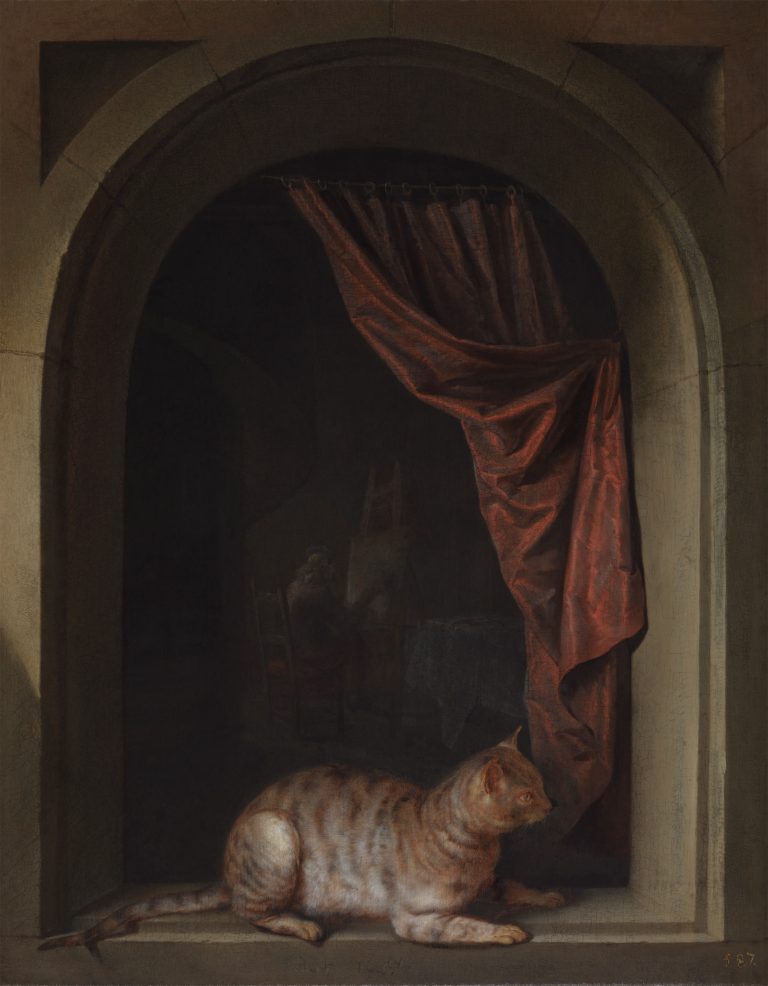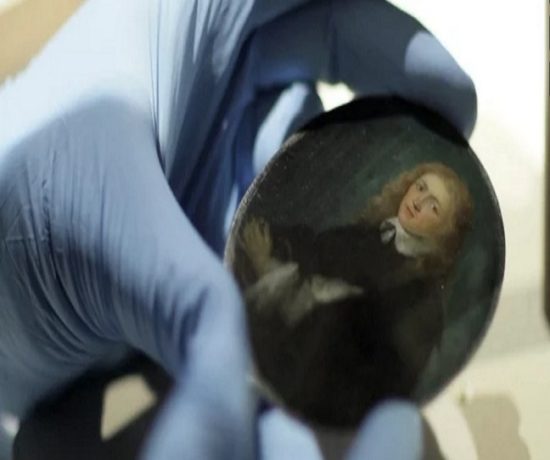Gerrit Dou, consummate master of artifice, was renowned for the illusionism of his niche pictures.1 As in this remarkable painting, Dou would place figural elements within the opening of a niche, a motif that served both as a framing device and an illusionistic construct. Dou not only situated these niches at the very front of the picture plane, but he also placed pictorial elements, like the tail of the cat in this picture, so that they extended into the viewer’s realm. To reinforce the connection to the external world, Dou always placed his light source so that it appeared to illuminate the front of the niche, generally from the upper left. The niche motif, thus, allowed Dou to examine issues of reality and illusionism that were central to his artistic concerns, ones that he reinforced in the meticulous rendering of different materials and textures, ranging from hard stone to soft fur.
In this striking painting Dou portrayed a grey-and-white-striped cat crouching in profile on a stone niche opening into an artist’s studio, a subject that is unique in the artist’s oeuvre.2 The cat’s individualized character and the specificity of the portrayal suggest that it was modeled after a particular animal.3 Using a brush consisting of only a few bristles, Dou applied countless minuscule strokes of multicolored paint to create the cat’s plush fur (fig 1). With its tail that seems to twitch, alert eyes, and unmistakable curiosity animating its presence, the cat appears alive as it focuses its attention on something to the right of the picture plane.
Dou appears to have conceived this unusual painting with a quite different composition. X-radiographs have shown that Dou initially painted a young woman leaning forward toward the cat before painting the red curtain hanging from the niche [(fig 2) and (fig 3)].4 An infrared reflectogram reveals a small rectangular shape in the lower right corner of the windowsill that may have been a mousetrap [(fig 4) and (fig 5)].5 Technical photographs also suggest that the niche once extended beyond the upper and right edges of the panel, suggesting that Dou initially began painting on a larger panel that he later reduced in format. This idea is reinforced by the fact that only a single bevel is found on the reverse of the panel, by which one can infer that the panel has been trimmed down on the other three sides.6
Other composition changes may also have occurred. The X-radiograph and infrared photograph indicate that a curtain was initially gathered about two-thirds up the left side of the painting and that a circular object once existed in the center-left, perhaps a globe resting on a table [(fig 6) and (fig 7)].7 Nevertheless, it is not certain whether or not these pictorial elements were part of a preliminary stage of the final composition or belonged to an earlier, altogether unrelated scene.8
A painting focused on a cat is quite unusual in seventeenth-century painting.9 The most comparable image occurs not in a painting but in an engraving—Cornelis Visscher’s (1629–58) The Large Cat, ca. 1657 (fig 8). Not only do the two works date from about the same year, they both portray a crouching feline in profile. Although Dou may have known of this print and it may have inspired his painting, a direct connection seems unlikely since the two works are quite different in character. The cat in Visscher’s engraving is dozing and has not noticed a small mouse in behind it, whereas Dou’s cat is alert and alive, intently gazing into the distance.10
Cat Crouching on the Ledge of an Artist’s Atelier relates to a very different iconographic tradition than that of Visscher’s engraving, one that stems from the animal’s reputation for extraordinary vision. This attribute was often exploited by late sixteenth- and early seventeenth-century artists in their depictions of the Allegory of Sight (Visus).11 An engraving from 1595, Sense of Sight by Jan Saenredam (1565–1607) after a design by Hendrick Goltzius (1558–1617), shows a cat, possibly an exotic lynx, looking out at the viewer, while a woman wearing a plunging décolleté admires herself in the mirror as her suitor embraces her and gazes wantonly at her bosom (fig 9).12 This aspect of sight is further expressed by the poignant gaze of the feline crouching next to Adam and Eve in Hendrick Golztius’s Fall of Man in the National Gallery of Art, Washington (fig 10).13 Reinterpreted here with the familiarity and immediacy of daily life, Dou emphasizes the cat as the embodiment of sight by highlighting its intense gaze and alert demeanor.
As in many of his other niche scenes, Dou also includes a scene in the deep recesses of the background that enhances the painting’s iconographic meaning. Here one sees an artist painting at his easel. Although Dou often included easels in the backgrounds of his paintings, nowhere else does he depict an artist actively engaged in painting.14 Near the artist is a violin resting on a table, a reference to the parallels that exist between a musician and a painter, both of whom use the imagination to create their works of art.15
The prominent red curtain, beautifully depicted with subtle violet highlights shimmering in the cascading of light across the iridescent fabric, also relates to the painting’s underlying concern for the interrelationship of illusion and reality. The depiction of such a dazzling curtain evokes the famous story from classical antiquity of Parrhasius, whose painting of a curtain was depicted in such a lifelike manner that it fooled his artistic rival, Zeuxis, who asked that it be pulled aside to reveal the supposedly-concealed painting beneath it. The story of artistic rivalry was retold by seventeenth-century art theorists such as Karel van Mander (1548–1606) in his Schilder-Boeck (1604) and by Phillips Angel (ca. 1618–62) in his Praise of Painting (1642).16 Dou explicitly referenced the anecdote in Painter with a Pipe and Book from ca. 1645 in the Rijksmuseum in Amsterdam (fig 11).17 Dou was often praised for his convincing illusionism by contemporaries like the poet Dirck Traudenius, who referred to Dou in 1662 as the “Dutch Parrhasius.”
The question remains as to why Dou turned his iconographic focus from a figural group involving a cat, a mousetrap, and young woman to a simplified scene of a cat alone within an architectural niche. The iconography of the cat and mousetrap was relatively novel in genre painting in the 1650s, and with his initial layout of the composition, Dou may have intended to explore the symbolism of love’s entrapment.19 The earlier compositional idea relates to paintings Dou made somewhat earlier in the 1650s, such as Kitchen Scene in Copenhagen, Statens Museum for Kunst, or The Mousetrap in Montpellier, Musée Fabre (fig 12).20 Dou’s final image emphasizing the cat’s sense of sight was an innovative way of reinterpreting this pictorial tradition to relate this theme to the status of the artist.
The present work is one of three known paintings by Dou featuring animals.21 King Augustus II acquired Cat Crouching on the Ledge of an Artist’s Atelier in the early eighteenth century for the imperial house collections of the Royal Palace in Dresden, where it remained, with nineteen other autograph paintings by Dou, until the third decade of the twentieth century.22 In the 1920s the Gemäldegalerie in Dresden de-accessioned the painting, and handed the work over to the former Royal House of Wettin as part of a group of restituted artworks from the State of Saxony.23 It was subsequently acquired by a private collector in Germany. It remained in that collection until 2006, when it was acquired by the Leiden Collection.

